The TransParcNet Meeting 2022 was held in “Binntal Veglia Devero Transboundary Park” from June 28th to July 1st. It was hosted by the Binntal Landschaftspark (CH) along with Ente di gestione delle Aree Protettte dell’Ossola (IT) and was the first live TransParcNet Meeting since the COVID pandemic had appeared at the beginning of year 2020.
PARKS AND CULTURAL HERITAGE: Ways to a closer involvement and to better identification of people with their parks.
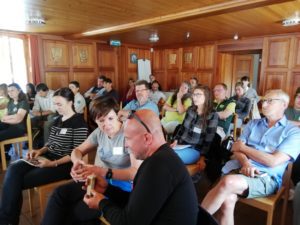
Participants listen to the presentations
Over 30 representatives of EUROPARC’s Transboundary Parks Network, met in Binntal Veglia Devero Transboundary Park from the 28 June to 1 July 2022, to discuss the theme “Parks and Cultural Heritage”. Of course, there was also time to share experiences, ideas and future projects among the Protected Areas of the Transboundary Parks Programme.
The “Binntal Veglia Devero Transboundary Park” is a certified Transboundary Protected Area since 2019. The cooperation between the bordering areas dates back since the early years of the 21st century.
“Binntal and Veglia Devero Parks share not only boundaries and mountains, but also cultures, trading, migrations and heritages.
On both sides of the border, our territories are shaped by a common need which comes from the past and remains alive nowadays: living in the mountains, finding a sound balance between man and natural resources.
These are the driving force that have been designing and painting our transboundary landscapes through the centuries.
Identification of people with the parks, inevitably relies on the ability of reading, understanding and sharing such values.
Shaping the future comes from living the present and knowing the past…”
From the Welcome message from the Boards and Staffs of the Binntal Veglia Devero Transboundary Park
Synopsis of the meeting
On 28th and 29th June, the event took place in Binn, in Switzerland’s part of the Transboundary area, the Binntal Landschaftspark. All presentations can be found at the bottom of this page.
The meeting started with a welcome from the hosts and an update about the Transboundary Parks Programme from EUROPARC’s Stefania Petrosillo. Then, participants heard from the EUROPARC Transboundary Park candidate 2022 Scarpe-Escaut Plain European Nature Park. The representatives, presented the area and their experience as European Group for Territorial Cooperation EGCT. Then Soledad Luna, the special guest and representative of the “Common Wadden Sea Secretariat”, explained the cross-border trilateral cooperation for the protection of a marine and coastal area in the UNESCO World Heritage between Denmark, Germany, and the Netherlands.
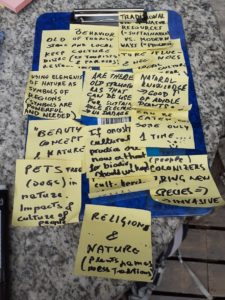
“Walkshop” wrapping up notes, picture by Daniele Piazza
Léa Marie d’Avigneau, culture expert of the Canton of Valais, led the following Round Table on “Cultural Intangible Heritage: experiences and examples from hosts and participants”. This allowed participants to enter the theme of this annual meeting. The works continued during the afternoon with the workshop “What are the cultural links between people and your transboundary parks?”. The day was fittingly concluded with a visit to the local Museum of Archeology and the Etnographic Museum.
Daniele Piazza, Andreas Weissen and Stefania Petrosillo. Photo EUROPARC
Soledad Luna from CWSS gives her speech during indoor morning session. Photo Daniele Piazza
Raymond Zingraff and Lisa Bardot give their speech during the morning session. Photo: Daniele Piazza
Intangible cultural heritage consists of the practices, representations, expressions, knowledge and skills – as well as the instruments, objects, artefacts and cultural spaces associated with them – that communities, groups and, where appropriate, individuals have recognized as part of their cultural heritage for several generations.
– Definition of the concept of intangible heritage by the Law on the promotion of culture in the canton of Valais.
Cultural heritage in practice
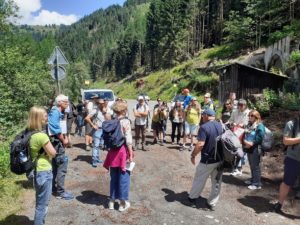
Ready to visit the Twingy Gorge and its art exhibitions, TransParcNet, picture by Daniele Piazza
On 30th and 1st of June, the group moved to Alpe Devero, Italy. At the Museum of “Alpeggio”, the visitor centre of the Park, they had the opportunity to exchange on “Agriculture and mountain dairy as intangible heritage”, with local farmers and with the president of the Park, who is a farmer herself.
An interesting open air working/walking session was organized to combine a visit on the ground and debate with 3 different “Walkshops”: TB protected areas and landscapes; TB protected areas and cultures – including trading and migration; TB protected areas and languages.
Getting to know how mountain cheese is produced in Crampiolo, Alpe Devero (intangible heritage and know-how, Bettelmatt cheese) day two. Photo: Daniele Piazza
Visits on the field of beautiful areas of the Transboundary Parks, an open air raclette (a typical culinary product which features melted mountain cheese, potatoes and vegetables) just prepared by the Binntal Landschaftspark staff as well as very testy local food produced by local Alpe Veglia farmers, and informal meeting, songs and leisure time together contributed to reinforce the friendship inside the TransParcNet and made this event very pleasant for everyone.
Conclusions
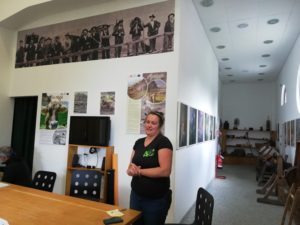
The President of Veglia Devero Park Vittoria Riboni presenting her experience as farmer. Photo: Stefania Petrosillo
The Trans Parc Net Meeting 2022 was intense and inspiring. After 2 years of COVID restrictions and withdrawals, meeting in person was great.
In (post-) COVID time, speaking about nature and intangible heritage makes a lot of sense: there has been a rise in the interest of people, tourists, and visitors in nature and open areas as “safe” places to ensure social distancing, naturally. Nonetheless, we can’t forget that our Transboundary Parks are made by nature and people who cross borders, walk trails, breed animals, migrate and trade. People are attracted not only by natural areas, but more and more by a mix of nature and vital local communities.
Managers should also consider local human dynamics and attitudes when plan and build projects. The TransParcNet participants really believe that some more focus should be put on the linkage among territories and our people in the forthcoming years.
The meeting has efficiently identified the “pillars” of parks and cultural heritage: culture, migrations and trading, languages have proven to be the common drivers of a variety of local processes, and transboundary cooperation should focus on such resources as well as on nature protection at the highest levels achievable.
Presentations
Stefania Petrosillo – Updates on EUROPARC Transboundary Programme
Soledad Luna – Trilateral Cooperation on the Protection of the Wadden Sea
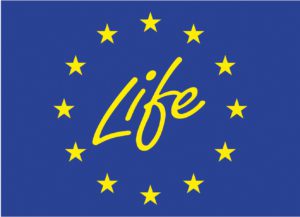
The TransParcNet is made possible thanks to financing through the LIFE Programme of the European Union.